Statistical Mechanics of Political Polarization
Abstract
:1. Introduction
2. Model
3. Results: Scenarios of Polarization
- The Democrats (group 1) are more cohesive than Republicans (group 2), i.e., J1 > J2;
- Independents (group 3) have no cohesion (J3 = 0) because they have no structure or means of identifying with each other, do not communicate, and do not recruit; therefore, they exert no influence on the other two groups and, as such, K13 = K23 = 0;
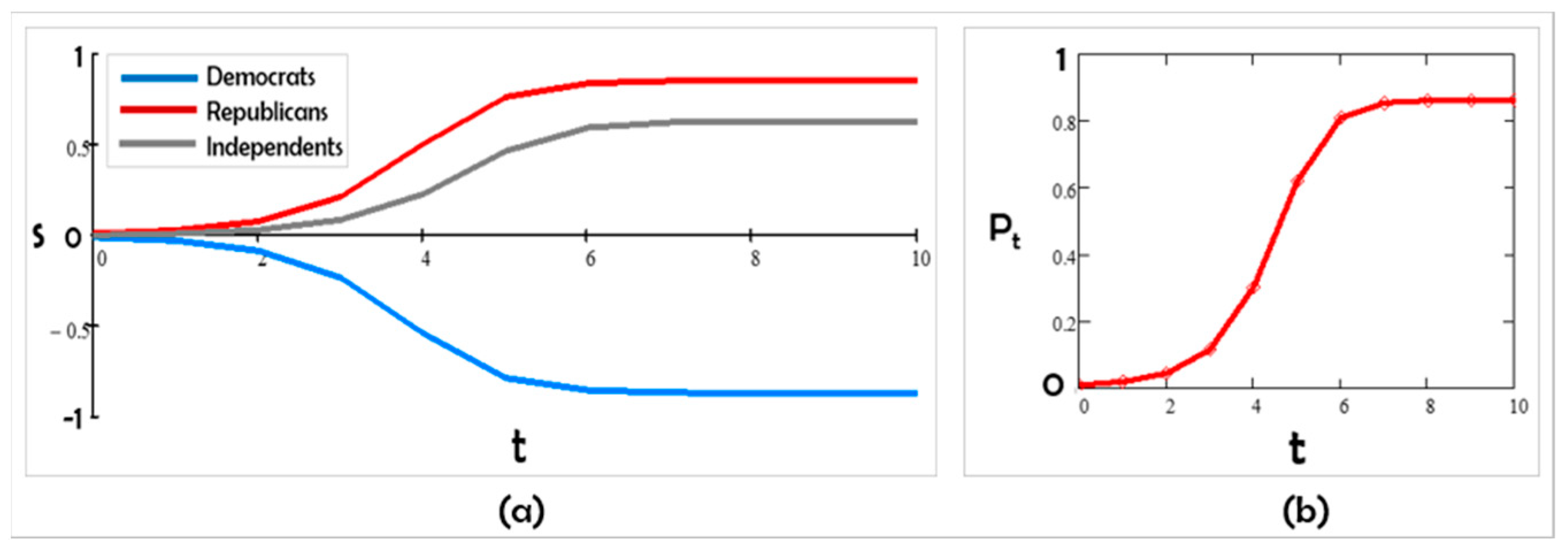
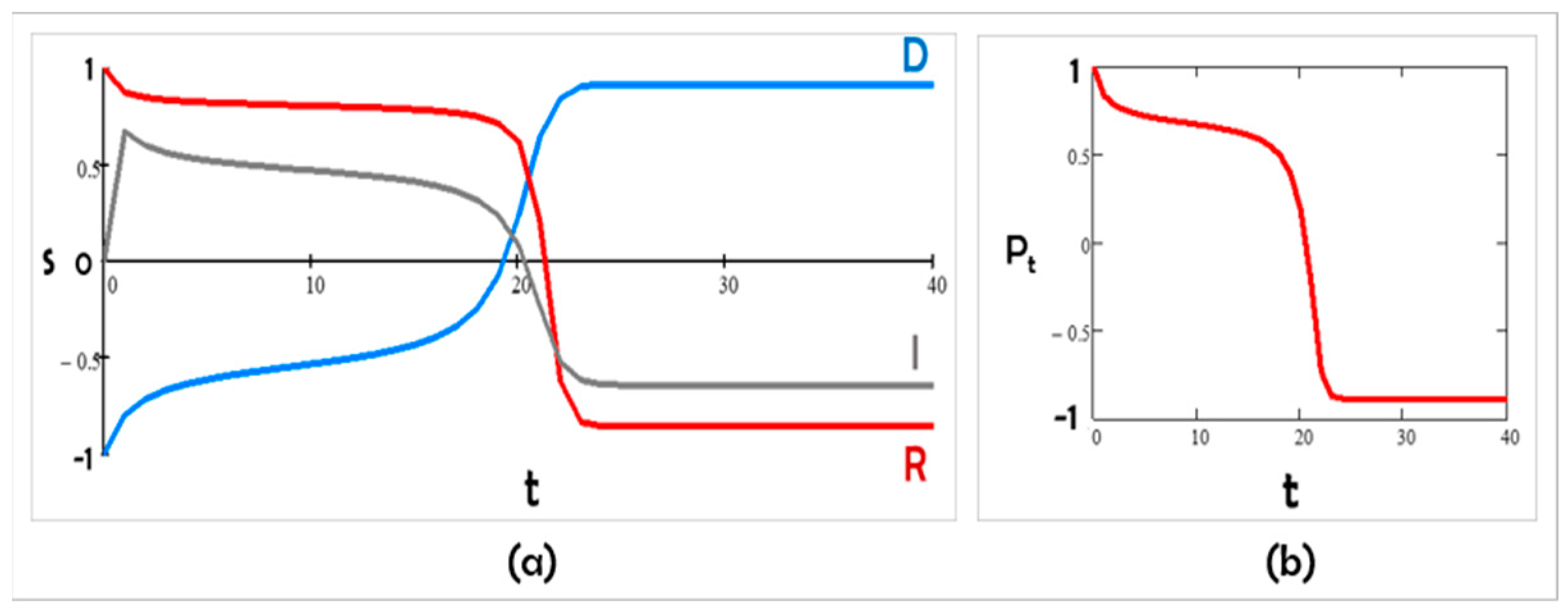

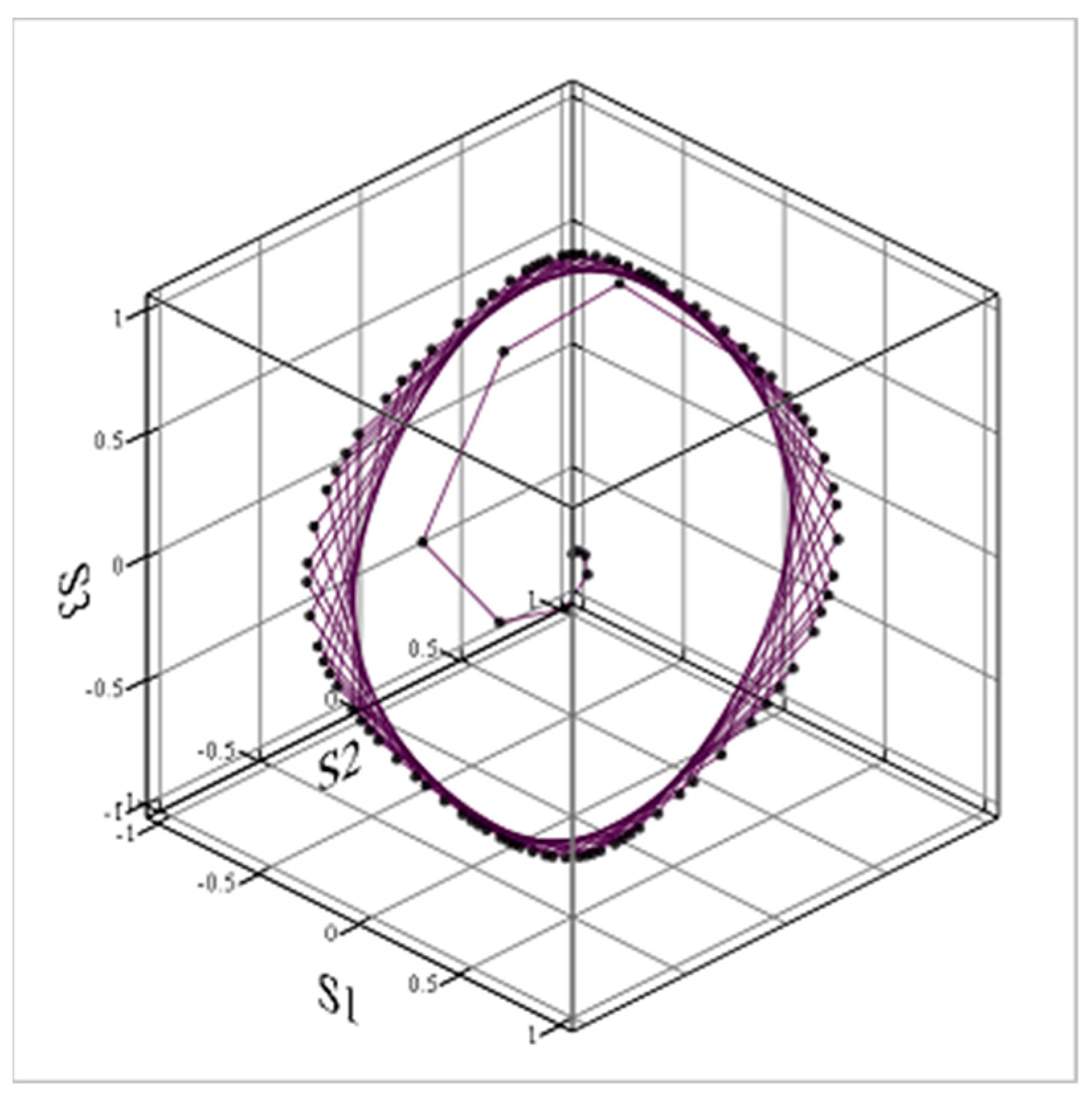
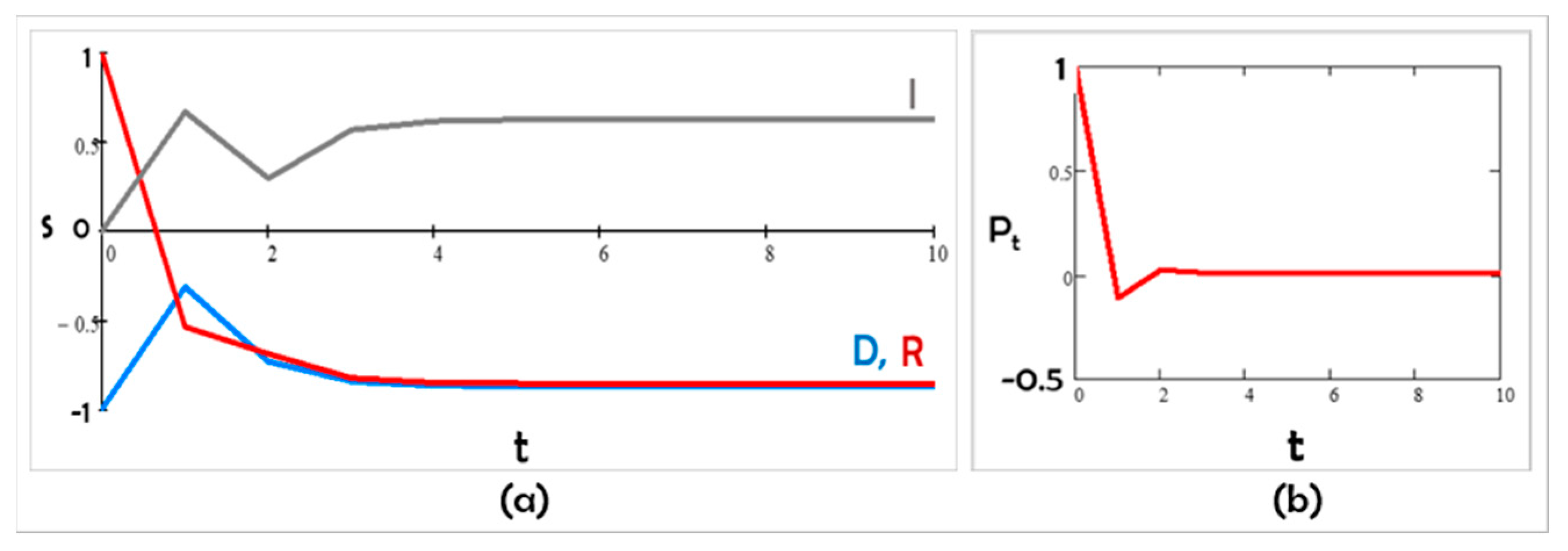
4. Discussion
5. Conclusions
Author Contributions
Funding
Institutional Review Board Statement
Informed Consent Statement
Data Availability Statement
Conflicts of Interest
References
- Baldassarri, D.; Gelman, A. Partisans without constraint: Political polarization and trends in American public opinion. Am. J. Sociol. 2008, 114, 408–446. [Google Scholar] [CrossRef]
- DellaPosta, D. Pluralistic collapse: The “oil spill” model of mass opinion polarization. Am. Sociol. Rev. 2020, 85, 507–536. [Google Scholar] [CrossRef]
- Zhu, Q. Investing in Polarized America: Real Economic Effects of Political Polarization. 2021. Available online: https://papers.ssrn.com/sol3/papers.cfm?abstract_id=3820979 (accessed on 29 August 2022).
- Druckman, J.N.; Levendusky, M.S. What do we measure when we measure affective polarization? Public Opin. Q. 2019, 83, 114–122. [Google Scholar] [CrossRef]
- Dandekar, P.; Goel, A.; Lee, D.T. Biased assimilation, homophily, and the dynamics of polarization. Proc. Natl. Acad. Sci. USA 2013, 110, 5791–5796. [Google Scholar] [CrossRef]
- Yardi, S.; Boyd, D. Dynamic debates: An analysis of group polarization over time on twitter. Bull. Sci. Technol. Soc. 2010, 30, 316–327. [Google Scholar] [CrossRef]
- Doherty, C.; Kiley, J.; Johnson, B. The Partisan Divide on Political Values Grows Even Wider. Pew Research Center. 2017. Available online: https://www.pewresearch.org/politics/2017/10/05/the-partisan-divide-on-political-values-grows-even-wider/ (accessed on 15 May 2022).
- Layman, G.C.; Carsey, T.M.; Horowitz, J. Party polarization in American politics. Annu. Rev. Political Sci. 2006, 9, 83–110. [Google Scholar] [CrossRef]
- Böttcher, L.; Gersbach, H. The great divide: Drivers of polarization in the US public. EPJ Data Sci. 2020, 9, 32. [Google Scholar] [CrossRef]
- Dimock, M.; Wike, R. America Is Exceptional in the Nature of Its Political Divide. Pew Research Center. 2020. Available online: https://www.pewresearch.org/fact-tank/2020/11/13/america-is-exceptional-in-the-nature-of-its-political-divide/ (accessed on 20 July 2022).
- Schaeffer, K. Far More Americans See ‘Very Strong’ Partisan Conflicts Now than in the Last Two Presidential Election Years. Pew Research Center. 2020. Available online: https://www.pewresearch.org/fact-tank/2020/03/04/far-more-americans-see-very-strong-partisan-conflicts-now-than-in-the-last-two-presidential-election-years/ (accessed on 20 July 2022).
- Macy, M.W.; Ma, M.; Tabin, D.R.; Gao, J.; Szymanski, B.K. Polarization and tipping points. Proc. Natl. Acad. Sci. USA 2021, 118, e2102144118. [Google Scholar] [CrossRef] [PubMed]
- Ginsburgh, V.; Perelman, S.; Pestieau, P. Populism and Social Polarization in European Democracies. CESifo Econ. Stud. 2021, 67, 371–404. [Google Scholar] [CrossRef]
- Abramowitz, A.I.; Saunders, K.L. Is polarization a myth? J. Politics 2008, 70, 542–555. [Google Scholar] [CrossRef]
- Jurkowitz, M.; Mitchell, A.; Shearer, E.; Walker, M. US Media Polarization and the 2020 Election: A Nation Divided. Pew Research Center. 2020. Available online: https://www.pewresearch.org/journalism/2020/01/24/u-s-media-polarization-and-the-2020-election-a-nation-divided/ (accessed on 20 July 2022).
- Axelrod, R.; Daymude, J.J.; Forrest, S. Preventing extreme polarization of political attitudes. Proc. Natl. Acad. Sci. USA 2021, 118, e2102139118. [Google Scholar] [CrossRef] [PubMed]
- McCoy, J.; Somer, M. Toward a theory of pernicious polarization and how it harms democracies: Comparative evidence and possible remedies. ANNALS Am. Acad. Political Soc. Sci. 2019, 681, 234–271. [Google Scholar] [CrossRef]
- Burgess, G.; Burgess, H.; Kaufman, S. Applying conflict resolution insights to the hyper-polarized, society-wide conflicts threatening liberal democracies. Confl. Resolut. Q. 2022, 39, 355–369. [Google Scholar] [CrossRef]
- Cárdenas, E. Social polarization and conflict: A network approach. Cuad. Econ. 2013, 32, 787–801. [Google Scholar]
- O′Connor, C.; Weatherall, J.O. Scientific polarization. Eur. J. Philos. Sci. 2018, 8, 855–875. [Google Scholar] [CrossRef]
- Rekker, R. The nature and origins of political polarization over science. Public Underst. Sci. 2021, 30, 352–368. [Google Scholar] [CrossRef]
- Lempert, R.; Popper, S.; Bankes, S. Confronting surprise. Soc. Sci. Comput. Rev. 2002, 20, 420–440. [Google Scholar] [CrossRef]
- Lempert, R.J. A new decision sciences for complex systems. Proc. Natl. Acad. Sci. USA 2002, 99 (Suppl. 3), 7309–7313. [Google Scholar] [CrossRef]
- de Jouvenel, H. Futuribles: Origins, philosophy, and practices—Anticipation for action. World Futures 2019, 11, 8–18. [Google Scholar] [CrossRef]
- Batty, M.; Torrens, P.M. Modelling complexity: The limits to prediction. Cybergeo Eur. J. Geogr. 2001. [CrossRef]
- Flache, A.; Mäs, M.; Feliciani, T.; Chattoe-Brown, E.; Deffuant, G.; Huet, S.; Lorenz, J. Models of social influence: Towards the next frontiers. J. Artif. Soc. Soc. Simul. 2017, 20, 2. [Google Scholar] [CrossRef] [Green Version]
- Lempert, R. Agent-based modeling as organizational and public policy simulators. Proc. Natl. Acad. Sci. USA 2002, 99 (Suppl. 3), 7195–7196. [Google Scholar] [CrossRef] [PubMed]
- Kaufman, S.; Kaufman, M.; Diep, H.T. Sociophysics of Social Conflict. Phys. Today 2018, 71, 12. [Google Scholar] [CrossRef]
- Galam, S. What is sociophysics about? In Sociophysics; Springer: Boston, MA, USA, 2012; pp. 3–19. [Google Scholar]
- Wang, S.S.H.; Cervas, J.; Grofman, B.; Lipsitz, K. A systems framework for remedying dysfunction in US democracy. Proc. Natl. Acad. Sci. USA 2021, 118, e2102154118. [Google Scholar] [CrossRef] [PubMed]
- Velásquez-Rojas, F.; Federico, V. Opinion dynamics in two dimensions: Domain coarsening leads to stable bi-polarization and anomalous scaling exponents. J. Stat. Mech. Theory Exp. 2018, 4, 043403. [Google Scholar] [CrossRef]
- Vazquez, F.; Saintier, N.; Pinasco, J.P. Role of voting intention in public opinion polarization. Phys. Rev. E 2020, 101, 012101. [Google Scholar] [CrossRef]
- Bruine de Bruin, W.; Saw, H.W.; Goldman, D.P. Political polarization in US residents′ COVID-19 risk perceptions, policy preferences, and protective behaviors. J. Risk Uncertain. 2020, 61, 177–194. [Google Scholar] [CrossRef]
- Epstein, J.M. Agent-based computational models and generative social science. Complexity 1999, 4, 41–60. [Google Scholar] [CrossRef]
- Liu, Q.; Zhao, J.; Wang, X. Multi-agent model of group polarisation with biased assimilation of arguments. IET Control Theory Appl. 2015, 9, 485–492. [Google Scholar] [CrossRef]
- Bramson, A.; Grim, P.; Singer, D.J.; Berger, W.J.; Sack, G.; Fisher, S.; Holman, B. Understanding polarization: Meanings, measures, and model evaluation. Philos. Sci. 2017, 84, 115–159. [Google Scholar] [CrossRef]
- Krueger, T.; Szwabiński, J.; Weron, T. Conformity, anticonformity and polarization of opinions: Insights from a mathematical model of opinion dynamics. Entropy 2017, 19, 371. [Google Scholar] [CrossRef] [Green Version]
- Crokidakis, N.; Galam, S. After 2018 Bolsonaro victory, is a 2022 remake feasible? Phys. A Stat. Mech. Its Appl. 2022, 600, 127598. [Google Scholar] [CrossRef]
- Vega-Oliveros, D.A.; Grande, H.L.; Iannelli, F.; Vazquez, F. Bi-layer voter model: Modeling intolerant/tolerant positions and bots in opinion dynamics. Eur. Phys. J. Spec. Top. 2022, 30, 2875–2886. [Google Scholar] [CrossRef]
- Diep, H.T.; Kaufman, M.; Kaufman, S. Dynamics of Two-group Conflicts: A Statistical Physics Model. Phys. A 2017, 469, 183–199. [Google Scholar] [CrossRef]
- Kaufman, M.; Kaufman, S.; Diep, H.T. Scenarios of Social Conflict Dynamics on Duplex Networks. J. Policy Complex Syst. 2017, 3, 3–13. [Google Scholar] [CrossRef]
- Kaufman, M.; Diep, H.T.; Kaufman, S. Sociophysics of intractable conflicts: Three-group dynamics. Phys. A 2019, 517, 175–187. [Google Scholar] [CrossRef]
- Kaufman, M.; Diep, H.T.; Kaufman, S. Sociophysics Analysis of Multi-Group Conflicts. Entropy 2020, 22, 214. [Google Scholar] [CrossRef]
- Kaufman, M.; Kaufman, S.; Diep, H.T. Multi-Group Conflict Paths: Anticipatory Scenarios of Attitudes and Outcomes. J. Policy Complex Syst. 2019, 5, 2. [Google Scholar] [CrossRef]
- Kaufman, S.; Koutsovoulou, M.; Kaufman, M. Multi-Group Labor-Management Negotiations: Model and Case Study. J. Policy Complex Syst. 2020, 6, 51–72. [Google Scholar] [CrossRef]
- Lempert, R.J.; Groves, D.G.; Popper, S.W.; Bankes, S.C. A general, analytic method for generating robust strategies and narrative scenarios. Manag. Sci. 2006, 52, 514–528. [Google Scholar] [CrossRef]
- Gallup Party Affiliation Trend since 2004. Available online: https://news.gallup.com/poll/15370/party-affiliation.aspx (accessed on 22 July 2022).
- Chu, O.J.; Donges, J.F.; Robertson, G.B.; Pop-Eleches, G. The microdynamics of spatial polarization: A model and an application to survey data from Ukraine. Proc. Natl. Acad. Sci. USA 2021, 118, e2104194118. [Google Scholar] [CrossRef] [PubMed]
- Galam, S. Contrarian deterministic effects on opinion dynamics: “The hung elections scenario”. Phys. A Stat. Mech. Appl. 2004, 333, 453–460. [Google Scholar] [CrossRef]
- Jędrzejewski, A.; Nowak, B.; Abramiuk, A.; Sznajd-Weron, K. Competing local and global interactions in social dynamics: How important is the friendship network? Chaos Interdiscip. J. Nonlinear Sci. 2020, 30, 073105. [Google Scholar] [CrossRef] [PubMed]
- Oestereich, A.L.; Pires, M.A.; Crokidakis, N. Three-state opinion dynamics in modular networks. Phys. Rev. E 2019, 100, 032312. [Google Scholar] [CrossRef]
- Chattoe-Brown, E. Using agent-based modelling to integrate data on attitude change. Sociol. Res. Online 2014, 19, 159–174. [Google Scholar] [CrossRef]
- Axelrod, R. The dissemination of culture: A model with local convergence and global polarization. J. Confl. Resolut. 1997, 41, 203–226. [Google Scholar] [CrossRef] [Green Version]
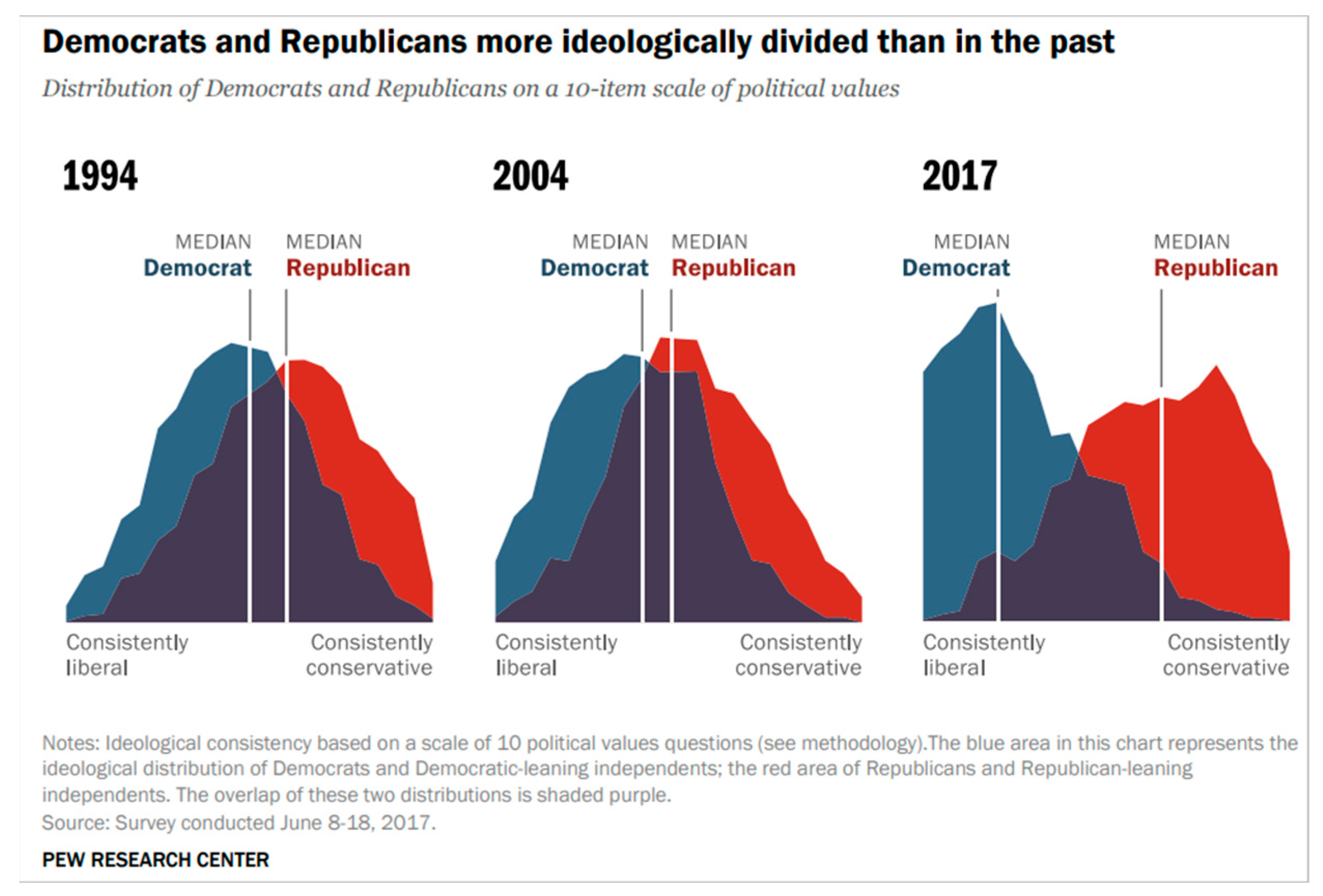

Publisher’s Note: MDPI stays neutral with regard to jurisdictional claims in published maps and institutional affiliations. |
© 2022 by the authors. Licensee MDPI, Basel, Switzerland. This article is an open access article distributed under the terms and conditions of the Creative Commons Attribution (CC BY) license (https://creativecommons.org/licenses/by/4.0/).
Share and Cite
Kaufman, M.; Kaufman, S.; Diep, H.T. Statistical Mechanics of Political Polarization. Entropy 2022, 24, 1262. https://doi.org/10.3390/e24091262
Kaufman M, Kaufman S, Diep HT. Statistical Mechanics of Political Polarization. Entropy. 2022; 24(9):1262. https://doi.org/10.3390/e24091262
Chicago/Turabian StyleKaufman, Miron, Sanda Kaufman, and Hung T. Diep. 2022. "Statistical Mechanics of Political Polarization" Entropy 24, no. 9: 1262. https://doi.org/10.3390/e24091262
APA StyleKaufman, M., Kaufman, S., & Diep, H. T. (2022). Statistical Mechanics of Political Polarization. Entropy, 24(9), 1262. https://doi.org/10.3390/e24091262







